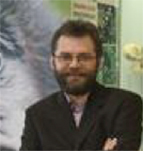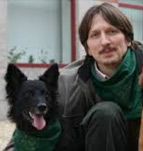Do you talk to your dog? Do you ever wonder if they actually understand what you are saying? Dr. Hare discusses how much our dogs understand about what we say and do, and how a dog named Rico learned to memorize and associate over 200 words.

Professor in the Evolutionary Origins of Mind at the University of Saint Andrews, where his research focuses on technical and social problem solving in animals.

Head of the Ethology department at Eötvös Loránd University and one of the best-known and most published experts on dog cognition and behavior.
Brian Hare: “DogSmarts” is brought to you by Purina Pro Plan Bright Mind—a breakthrough in pet nutrition created to nourish a dog’s mind. Is your dog’s food feeding your dog’s brain? Discover more at BrightMindEffect.com.
Canines and humans are not just connected by companionship. In fact, we are evolutionarily linked and tied together by something far more complex—our brains.
Join me as we take a peek into the inner workings of the canine brain through the lens of human cognition. With a mix of stories and interviews from leading psychologists, anthropologists, veterinarians, and dog owners, we’re going to tackle questions of memory, word learning, nutrition, and even love.
I’m Brian Hare, Founder of Dognition, and Professor at Duke University in Cognitive Neuroscience.
Welcome to “Dog Smarts”.
BH: OK, admit it. Do you talk to your dog? Do you ever wonder if they understand what you’re saying? We’re going to talk about how much our dogs actually understand about what we think or say. When I say mind reading, I’m talking about something specific.
Josep Call: That’s for having me.
BH: That’s Josep Call.
JC: I’m a professor in the Evolutionary Origins of Mind at the University of Saint Andrews.
BH: Josep and I go way back. When I was an undergraduate, we were working on a very simple gesture with very large implications – pointing.
JC: The pointing gesture is a communicative act that allows us to indicate to others what are the things that we want or the things that we see our mental state. It’s a way, if you want, to externalize things that are private, that are internal like mental states. So, when you see somebody gesture, you get an idea of what are they thinking or what they want, but on top of that, you can change what somebody thinks or wants by indicating certain things.
BH: So, if dogs are really good at using pointing gestures of human’s, what does this mean for the idea that pointing is somehow special to humans? The first thing we had to do is really know is what we see dogs doing the same as what we see people doing? And little did I know on the other side of the world, while we were doing these first experiments, in Hungary, a very well respected scientist, was doing the exact same thing.
Adam Miklosi: My name is Adam Miklosi, I am working at the Eotvos University in Budapest, Hungary. I am the head of the Department of Ethology.
BH: So what did you find?
AM: Young children and dogs start at the very same level, so they seem to understand quite well the human pointing gesture, and here basically I mean that if the human is pointing to an object, then both the one year old child and the dog can find it.
BH: Incredible. Dogs were using human gestures to find hidden food. But Adam didn’t stop there. Adam gave his students wolf puppies when they were just a few days old, and he asks them to raise them, to raise them like dogs. And then what he found was...
AM:Dogs are relatively early able to follow the pointing gesture, and I assume this happens because they have a lot of experience with human hand movements and interactions and communication. Wolves learn it also, I mean they're able also to follow the pointing gesture, but they do it at a much later time in development, usually when they are young adults.
BH: So this ability to read human social cues, is it something unique to dogs?
AM:I think that yes, domestication, is behind these differences, these early differences, and these lead to large differences as the dogs grow older.
BH: We’ll be back with more DogSmarts... I’m Brian Hare.
“DogSmarts” is brought to you by Purina Pro Plan Bright Mind—the result of years of research into the positive impact nutrition can have on a dog’s cognitive health. For dogs seven and older, there’s Bright Mind Adult 7Plus, with enhanced botanical oils shown to promote alertness and mental sharpness in dogs seven and older, with visible results within 30 days, helping them think more like they did when they were younger. For adult dogs, there’s Bright Mind Adult, featuring a proprietary blend of brainsupporting nutrients. When fed daily, the blend of nutrients in Bright Mind Adult helps support a dog’s cognitive health throughout adulthood—to help him reach his full potential. Available exclusively at Pet Specialty Retailers such as Petsmart, Petco and Pet Supplies Plus. Purina Pro Plan Bright Mind Adult and Adult 7Plus. Is your dog’s food feeding your dog’s brain? Discover more at BrightMindEffect.com.
Welcome back to DogSmarts. I’m Brian Hare.
BH: Dogs have the ability to enter into our mental world. They are divining meaning from our gestures. So what about language. We know that dogs don’t talk like we do, but how much of what we are saying do they actually understand?
BH: I'm gonna start simply by just asking you, who is Rico?
JC: Rico was a Border Collie that he knew some words. He knew the word for a number of objects. So Rico was a border collie that was with a family here in Germany. He became known to us because he appeared in a TV program. And in this TV program, a very popular program in Germany, presumably this dog was capable of identifying the objects by their name. So the owner would call the name of an object and then Rico would go and fetch it. And he would do it right every time.
BH: What did you think, what was your first thought? You know, and especially reflecting on how kids learn?
JC: You know, I was very skeptical because I knew when others attempted to teach a dog the words for objects, and that attempt took place like more than a 100 years ago, and this dog learned about 5 or 6, 5 or 6. The dog Rico that appeared on TV was supposed to know 200. So that was like, incredible.
BH: So then Josep...
JC: Contacted the family and asked them would it be possible to test Rico? And they were very nice and they were very open and they said of course.
BH: So what they found was that Rico did know over 200 words, which is impressive enough, but even more amazing is how Rico was learning the words that he knew.
JC: Then we got very interested in how is he capable of learning so fast? So we did a test that is also used with children, how children learn words, and there is a thing that is called fast mapping.
BH: The reason why kids can learn words so fast is they’re making inferences. They hear someone say a new name, and they put it together with a new object. With Rico, on the first trial, they asked him to bring back an object he knew the name of. Then...
JC: The second one, we also asked for one that he knew, and then on the third one or sometimes, the second, sometimes the third then we would ask for something that he had never heard before. So we used the word that was new to him so we'd say, for instance, 'bring the book'. So Rico would go in the kitchen and then he would look at all the objects that are there all of them were familiar except one. And what Rico did is he grabbed this one that was new and brought it with him. So, he was able to see that the new word that we had used, did not correspond to any of the familiar objects that were there. The labels for those objects had already been taken, so to speak. So he inferred that the only one that is left is this one, and that's the one that he brought.
BH: So there you go. It seems like we are actually having a conversation with our dogs, and that they are capable of far much more than we give them credit for.
Many thanks to Dr. Josep Call, Professor in the Evolutionary Origins of Mind at the University of Saint Andrews and Dr. Adam Miklosi, Head of the Department of Ethology at Eötvös University in Budapest, Hungary.
“Dog Smarts” is produced by Panoply Custom Studios and is sponsored by PurinaProPlan BrightMind, a breakthrough in pet nutrition created to nourish a dog’s mind. Discover more at BrightMindEffect.com.